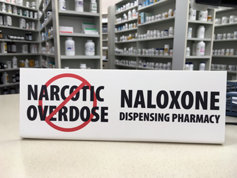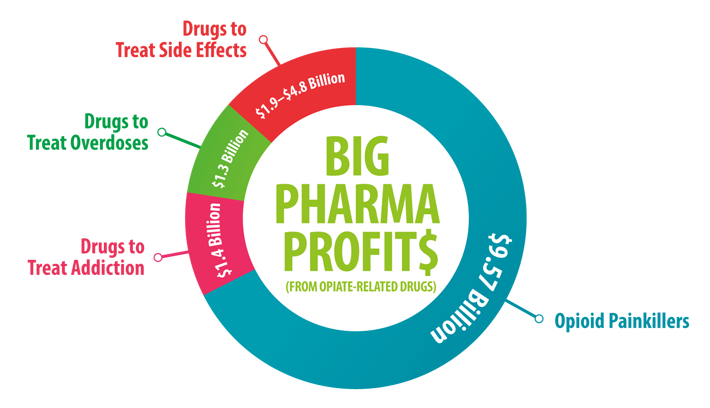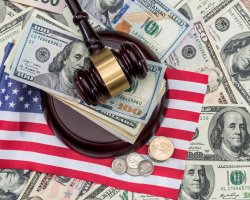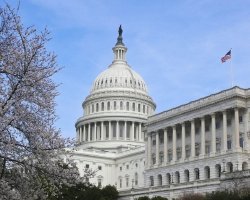Behind the Curtain
of the Opioid Epidemic:
The Companies That Profit
For a mother of a person struggling with opioid addiction, there’s only one motivation: Saving her child’s life.
For a number of pharmaceutical companies, there's an entirely different motivation: Raking in billions in profits from drugs that are more in demand because of the opioid epidemic.
To a family, this motivation is unconscionable but the evidence is there. Pharmaceutical companies see the potential for money to be made by manufacturing and marketing drugs that are needed because of widespread addiction to prescription or illicit opioids.
Let’s look at Suboxone, for example.
Suboxone is a combination of two drugs: buprenorphine and naloxone. Buprenorphine is an opioid painkiller much stronger than heroin. Naloxone is an antidote to opioids that is supposed to prevent a patient from trying to abuse Suboxone to get high. This formula (that is itself addictive) is used as treatment for opioid addiction. It does not cure anything. It maintains a patient on an addictive drug with the idea that he (or she) will not incur withdrawal sickness and will be able to stabilize his life.
It’s only been in the past decade that this drug has become popular as a solution for opioid addiction. Government agencies are united in their endorsement for this use of Suboxone as a treatment drug for opioid addiction. But continuing the use of Suboxone does not result in full recovery and sobriety. It only maintains a person on an addictive drug.
Tens of Thousands of Doctors Offer Suboxone—and Maybe Not Much Else

The doctors prescribing Suboxone to those who have been addicted to opioids are not specialists in addiction recovery. The only requirements to offer this drug are completion of an eight-hour online course of study and then application to the Drug Enforcement Administration for permission to start accepting patients for treatment.
Some of these practitioners use Suboxone as a bridge to real recovery by offering counseling services to each person and ensuring that patients taper off the drug as soon as possible.
Other practitioners openly state their intention to keep patients on this drug “indefinitely.” In fact, many medical practitioners who prescribe this drug to patients have no qualifications to help a person straighten out his life so he can enjoy a sober life.
In the U.S., there are tens of thousands of practitioners who have met the qualifications and are handing out this drug to their patients every day. Many operate on a cash-only basis. Each new patient is processed for a fee ranging from $200 to $600 and followup visits (that might be weekly or as far apart as every other month) range from $90 to $180.
The Pain News Network calls buprenorphine a “coming economic bonanza” with the potential to add a half-million dollars a year to a doctor’s practice.
The Pharmaceutical Company Profiting from Suboxone
Who’s profiting from all this Suboxone? UK pharmaceutical company Reckitt Benckiser. Far from being a public-spirited corporation interested in the well-being of patients, Reckitt Benckiser was sued by thirty-five states for profiteering from the sale of Suboxone at artificially high prices.
Is buprenorphine even a workable solution to addiction? The New York Times reported, “Buprenorphine has become both medication and dope: a treatment with considerable successes and also failures, as well as a street and prison drug bedeviling local authorities. It has attracted unscrupulous doctors and caused more health complications and deaths than its advocates acknowledge.”
Who Else Might Be Profiting?
It seems like new companies who have worked out ways of profiting from this disastrous situation keep cropping up all the time.
In October 2016, the Washington Post reported on an entirely new market opening up for a pharmaceutical company sharp enough to spot an opportunity embedded in the opioid epidemic. If you watched Super Bowl 50, you may have seen an ad for a new drug formula named Movantik. The ailment this drug treats? “Opioid-induced constipation.”
Opioids slow the movement of waste products through the bowel. In fact, opioids have long been used to treat diarrhea that would not respond to any lighter drugs. With millions of Americans on long-term treatment with prescription opioids and millions more abusing prescription or illicit opioids, there is a huge market for a drug specifically designed to treat this type of constipation.
Who stepped up to offer Movantik to those suffering from constipation? Pharmaceutical giant AstraZeneca.
There’s also the makers of naloxone—the drug that brings people back from an opioid overdose. This drug is in phenomenal demand as cities across the country lose thousands of citizens to heroin and fentanyl. In some states, this drug is carried by every first responder and in other states, it’s available without a prescription to families who have not yet been able to get a loved one through an effective rehabilitation program.

In 2015, the price of naloxone manufactured by Amphastar Pharmaceuticals skyrocketed. Originally, one shot of this drug cost about a dollar. The price climbed to $40 a dose by mid-2015. More profiteering?
In July 2017, a White House Commission on the opioid crisis recommended that a state of emergency be declared that would give the Health and Human Services Department the power to negotiate lower prices for this drug.
The Shocking Totals
The Washington Post worked out the values of the opioid prescription market and the new markets that have sprung up to treat the problematic side effects of opioids.

- Opioid painkillers: 2015 U.S. sales: $9.57 billion
- Drugs that treat addiction: 2014 U.S. sales: $1.4 billion
- Drugs that treat overdoses: Estimated annual sales $1.3 billion
- Drugs to treat side effects such as constipation: Estimated at $1.9 billion to $4.8 billion.
It’s no wonder that pharmaceutical companies see a fabulous opportunity for profits. But the more these companies profit, the less motivated they and anyone they influence will be to truly end the opioid epidemic.
The losers are the loving families and those who are driven to continue to use opioids to the point of losing their lives. The winners—if you can call them that—are giant pharmaceutical companies diving in to take advantage of all this pain and loss.


 ®
®